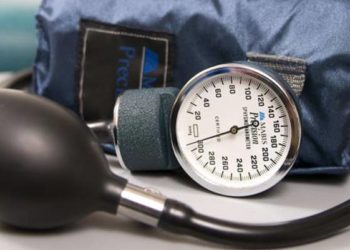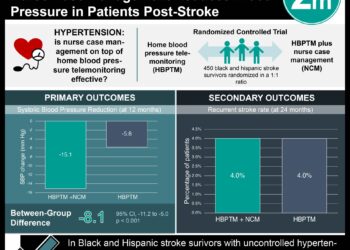No difference in mortality for intensive versus standard reduction in blood pressure in intracerebral hemorrhage: The ATACH-2 trial
1. There were no significant differences in the proportion of death and disability in patients with intracranial hemorrhage with blood pressures maintained at 140-179 mmHg versus 110-139 mmHg.
2. There were no significant differences in EQ-5D scores and hematoma expansion in patients with intracranial hemorrhage with blood pressures maintained at 140-179 mmHg versus 110-139 mmHg.
Evidence Rating Level: 1 (Excellent)
Study Rundown: In patients with intracerebral hemorrhage, a rise in blood pressure above normal and premorbid values typically occurs within the first 24 hours of symptom onset. This hypertensive response may be associated with hematoma expansion, as high blood pressure levels may result in elevated hydrostatic pressures at the bleed site, resulting in larger initial hemorrhage and a subsequently larger hematoma. In the Antihypertensive Treatment of Acute Cerebral Hemorrhage II (ATACH-2) trial, researchers evaluated the effects of different target systolic blood pressures (SBPs) when treating acute hypertensive response in intracerebral hemorrhage on death and disability. Their data demonstrated that there were no significant differences between intensive vs. standard SBP control in terms of death at 3 months from randomization or neurologic deterioration 24 hours after randomization. Additionally, there were no significant differences in EQ-5D reports or hematoma expansion between the two groups. The trial was discontinued for futility before reaching target enrollment.
Click to read the study, published today in NEJM
Relevant Reading: The importance of acute hypertensive response in ICH
In-Depth [randomized controlled trial]: In the ATACH-2 trial, 1000 patients were randomized to be in a group with a target SBP of 110-139 mmHg (intensive treatment; n = 500) or 140-179 (standard treatment; n = 500), with antihypertensives being started within the first 4.5 hours. Patients had to be 18 years of age with a Glasgow Coma Scale of 5 and with an intracranial parenchymal hematoma <60cm3 on CT scan. The primary outcome was the proportion of patients who died or experienced disability, and secondary outcomes included EQ-5D utility index scores and hematoma expansion on CT 24 hours after randomization. Of the 961 patients in which the primary outcome occurred, 38.7% (186/481) were from the intensive group and 37.7 (181/480) were from the standard group (RR 1.04; 95%CI 0.85-1.27). There were no significant differences between groups for the rate of death at 3 months or neurologic decline 24 hours from randomization. Additionally, EQ-50 and hematoma expansion did not differ significantly between the intensive and standard groups. The rate of adverse renal events occurring 7 days from randomization was significantly higher in the intensive vs. standard group (9.0% vs. 4.0%, p = 0.002). Primary treatment failure occurred in 61 patients (12.2%) in the intensive group and 4 (0.8%) in the standard group (p < 0.001).
Image: PD
©2016 2 Minute Medicine, Inc. All rights reserved. No works may be reproduced without expressed written consent from 2 Minute Medicine, Inc. Inquire about licensing here. No article should be construed as medical advice and is not intended as such by the authors or by 2 Minute Medicine, Inc.







